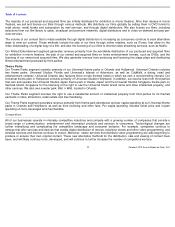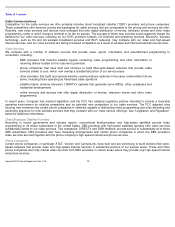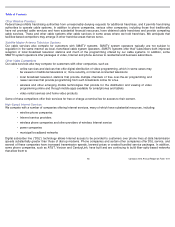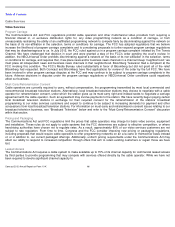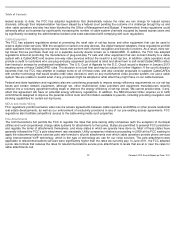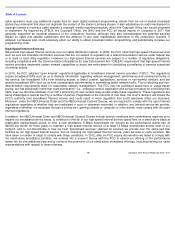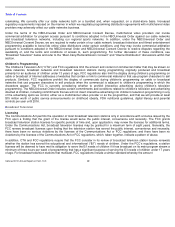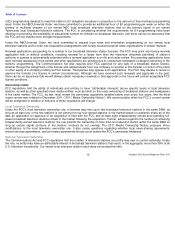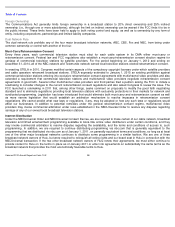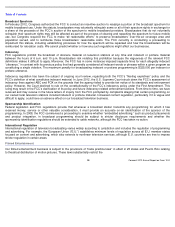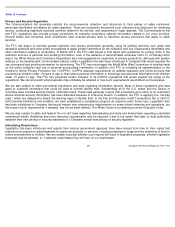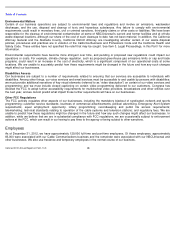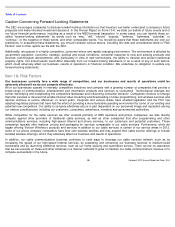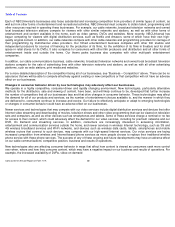Comcast 2012 Annual Report Download - page 23
Download and view the complete annual report
Please find page 23 of the 2012 Comcast annual report below. You can navigate through the pages in the report by either clicking on the pages listed below, or by using the keyword search tool below to find specific information within the annual report.
Table of Contents
A federal program known as the Universal Service program generally requires telecommunications service providers to collect and
pay a fee based on revenue from their services into a fund used to subsidize the provision of telecommunications services in high-
cost areas and Internet and telecommunications services to schools, libraries and certain health care providers. The FCC issued an
order in November 2011 that changed the way that a majority of Universal Service funds are allocated and began implementing that
order in 2012. By focusing on broadband and wireless deployment, and moving away from supporting traditional telephone service,
the changes could assist some of our competitors in more effectively competing with our service offerings, while others could receive
less funding. The actual impact of the changes is not yet known. The FCC’
s ruling is under review in the U.S. Court of Appeals for
the Tenth Circuit.
In addition, in November 2011, the FCC initiated a further rulemaking on IP interconnection issues, which may have an impact on
Internet interconnection arrangements. We have a number of peering and transit arrangements with other network operators, and
these arrangements historically have not been regulated by the FCC. We cannot predict what, if any, proposals might be adopted or
what effect they might have on our business.
In addition, Congress and federal regulators have adopted a wide range of measures affecting Internet use, including, for example,
consumer privacy, consumer protection, copyright protection, defamation liability, taxation, obscenity and unsolicited commercial
email. State and local governments also have adopted Internet-
related regulations. Furthermore, Congress, the FCC, and certain
state and local governments are considering proposals to impose customer service, quality of service, expanded copyright protection
requirements, taxation, child safety, privacy and standard pricing regulations on high-
speed Internet service providers. It is uncertain
whether any of these proposals will be adopted. The adoption of new laws or the application of existing laws to the Internet could
have a material adverse effect on our high-speed Internet business.
Voice Services
We provide voice services by using interconnected VoIP technology. The FCC has adopted a number of regulations for providers of
nontraditional voice services such as ours, including regulations relating to customer proprietary network information, local number
portability duties and benefits, disability access, E911, law enforcement assistance (CALEA), outage reporting, Universal Service
Fund contribution obligations, and certain regulatory filing requirements, but has not yet ruled on whether interconnected VoIP
service should be classified as an “information service” or a “telecommunications service”
under the Communications Act. The
classification determination is important because telecommunications services are still regulated more pervasively than information
services. The regulatory environment for our voice services therefore remains uncertain at both the federal and the state levels. Until
the FCC definitively classifies interconnected VoIP service, state regulatory commissions and legislatures may continue to
investigate imposing regulatory requirements on our voice services. For example, state commissions in Vermont and New
Hampshire have issued orders finding that our voice services qualify as telecommunications services subject to state regulation,
although we have challenged both orders in court. In some cases, state legislation precludes state regulation of VoIP-
based services
notwithstanding how they are classified.
Because the FCC has not determined the appropriate classification of our voice services, the precise scope of interconnection
regulations applicable to us as a provider of nontraditional voice services is not clear. In light of this uncertainty, providers of
nontraditional voice services typically either secure CLEC authorization or obtain interconnection to traditional wireline phone
company networks by contracting with an existing CLEC, whose right, as a telecommunications carrier, to request and obtain
interconnection with the traditional wireline phone companies is set forth in the Communications Act. We have arranged for such
interconnection rights through our affiliated CLECs. While some traditional wireline phone companies have challenged our
Comcast 2012 Annual Report on Form 10-K
20



